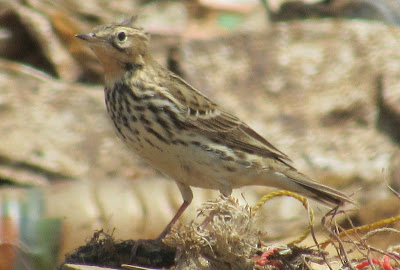Our first stop was at the water treatment works south of Nouakchott in a district known as Riyadh.
There is a fresh water lake there. It was not as large as on our last visit.
Nevertheless, there were some interesting findings. First of all, we found a kentish plover chick. A look at the Atlas of Mauritanian birds shows Kentish Plover has found breeding in the Nouakchott area before. However, this is the furthest south it normally breeds in west Africa.
kentish plover 1
A parent of the chick was near-by all the time.
kentish plover 2
Other interesting birds in the same stretch of water included a lone ortolan bunting.
ortolan bunting
Weavers are rare in the Nouakchott area with some evidence a few move up in the rainy season.
Vitelline masked weaver
The one most often found this far north is Vitelline masked weaver though it is never common.
little egret
I don't ever find little egret easy to separate from white morph western reef heron. Indeed their DNA arguably suggests they ought to be treated as one species.
little egret
black-crowned sparrow lark
common ringed plover
After 90 minutes or so at the lake we headed north west to the coast south of the fishing port.
great cormorant (white-breasted)
Sightings were a bit thin though great cormorant were seen on the old wharf. I had seen some at exactly the same place at the same time last year too but not outside April or May.
tree pipit
The large, very smelly, waste dump near the fishing port is always worth a visit. Yellow wagtail were numerous as were both barn swallow and sand martin hawking above. There was only one tree pipit though.
grey "pallid" heron
The whole city is being pumped out by the Chinese at the moment. While this means the water level is much lower overall helping residents fight rising damp, it has meant the total destruction of F-Nord lake. It has also had an effect on the man-made lagoons south of the fishing village. While it is not always the case, generally, there is less water being pumped into them. The previously guaranteed gulls, terns and waders are many fewer. A pallid heron was the best bird on this visit.
In early May I returned to the waste water site north of the city. To my surprise I added a species to my country list. I will write about that next.












No comments:
Post a Comment